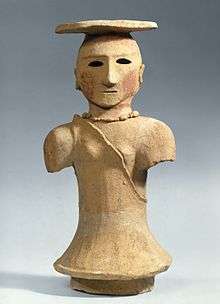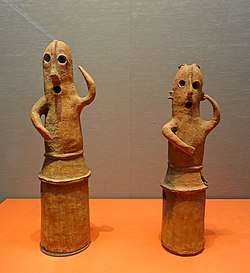Haniwa
The Haniwa (埴輪) are terracotta clay[2][3] figures that were made for ritual use and buried with the dead as funerary objects during the Kofun period (3rd to 6th centuries AD) of the history of Japan. Haniwa were created according to the wazumi technique, in which mounds of coiled clay were built up to shape the figure, layer by layer.[4]

Haniwa were made with water-based clay and dried into a coarse and absorbent material that stood the test of time. Their name means "circle of clay", referring to how they were arranged in a circle above the tomb. The protruding parts of the figures were made separately and then attached, while a few things were carved into them. They were smoothed out by a wooden paddle. Terraces were arranged to place them with a cylindrical base into the ground, where the earth would hold them in place.
During the Kofun period, a highly aristocratic society with militaristic rulers developed. The cavalry wore iron armor, carried swords and other weapons, and used advanced military methods like those of northeast Asia. Many of them are represented in haniwa figurines for funerary purposes.
The most important of the haniwa were found in southern Honshū—especially the Kinai region around Nara—and northern Kyūshū. Haniwa grave offerings were made in many forms, such as horses, chickens, birds, fans, fish, houses, weapons, shields, sunshades, pillows, and humans. Besides decorative and spiritual reasons of protecting the deceased in his afterlife, these figures served as a sort of retaining wall for the burial mound.
Because these haniwa display the contemporary clothing, hairstyle, farming tools, and architecture, these sculptures are important as a historical archive of the Kofun Period.
Everyday pottery items from that period are called Haji pottery.
History of Haniwa
Origin
Earlier clay figurines appeared during the Jōmon period called dogū.
Hiroaki Sato cites a passage from the Nihon Shoki, in which Emperor Suinin issued an imperial edict concerning funerals: "From now on make it a rule to erect clay figures and not to hurt people." Thus, these clay figures may have replaced live human sacrifices.[5]
The origin of haniwa started during the latter part of the Yayoi period around the Kingdom of Kibi. During this time special earthenware figurines and bowls started to appear on top of the tombs of leaders. The early sculptures exceeded 1 m (3.3 ft) in length. They consisted of a cylindrical portion, which represented the torso, and a skirt-shaped portion at the base, which represented the legs. Many times a special insignia or pattern would be displayed on the torso. Sometimes an obi would be placed around the torso. These sculptures are thought to have been used as part of a funeral ritual. Other than the Kibi area, the only other place these sculptures were found was in the Izumo province.
During the latter part of the 3rd century AD, these sculptures started to appear on top of the imperial grave mounds in the Kinai region. During this time more elaborate haniwa appeared with earthenware bowls. It is believed that the movement of these sculptures and haniwa from the Kibi region to the Kinai region is indicative of an increase in their importance.
Later developments
During the earlier part of the Kofun period (later 3rd century AD) the only earthenware haniwa were cylindrical; however, toward the early 4th century AD, shield and other tool-shaped haniwa started to appear. Additionally, during the middle Kofun period (mid-5th century AD) shrine maiden, horse, dog, and other animal-shaped haniwa were introduced. As the practice of ceremonial burial mounds declined in the mid-6th century AD, haniwa became rarer in the Kinai region; however, haniwa were made in abundance in the Kantō region.
It is not uncommon for some haniwa to be painted with red dye or other colors. Besides the cylindrical haniwa (enkei-haniwa), another common type was the house-shaped haniwa (keisho-haniwa). Other things that fell into the category of keisho-haniwa were those shaped like humans, animals, and swords. The details on the haniwa give information about the elite buried in the tomb, as well as valuable knowledge of the tools or other objects people of that time used. The military haniwa inform archeologists of the armour and weapons, as well as the status symbols of these military branches.
- Seated woman
- Haniwa houses
Significance
Originally, the cylindrical type haniwa were set on top of the funeral mounds, so it is believed that they had a purpose in funeral rituals; however, as the haniwa became more developed, they were set toward the outside of the grave area. It is thought that they were used as boundary markers for the borders of the gravesite.
There is a theory that the soul of the deceased would reside in the haniwa, as the earlier haniwa were placed on top of the funeral mounds. There are haniwa that are equipped with weapons and armor. These are thought to be containers for souls. The armor and weapons would drive away evil spirits and protect the buried ruler from calamity. Because the horse- and animal-shaped haniwa were normally neatly arranged into a line, it is believed that they were part of a sending-off ceremony.
In modern society

Although the religious implications of the haniwa have largely declined in modern society, the sculptures are prized by many for their aesthetic and historical significance. The works of Isamu Noguchi, for example, were heavily influenced by the haniwa.[6][7] They have been accepted as "Pure Art", according to Time magazine.[8] Beyond simple appreciation as artistic sculptures, modern popular culture has, in some cases, portrayed the haniwa as containing a sentient entity and not just as a simple empty sculpture. The most common portrayal depicts the haniwa with a rounded, pot-like shape, bearing two deep eyes, a wide mouth, and two featureless "arms" on opposite sides of the "pot".
The portrayal of living haniwa has—since the late 1990s—become widespread, being featured in trading cards; video games such as the Animal Crossing, Dragon Quest and Kirby series; and television. In many of the depictions, the haniwa is primarily presented as a ghostlike, malevolent creature; without attempting to retain the historical aspect of the haniwa's religious nature. In Animal Crossing, haniwa are called Gyroids in the English translation, and are furniture only found buried in the ground. A Gyroid named Lloid appears in several games of the series as a helper NPC, collecting donations to go towards town upgrades and construction projects.
See also
- Mozu Tombs
- Terracotta Army, of ancient China
- Ushabti, ancient Egyptian burial sculpture
- Cult image, also known as an idol
- Ancient Egyptian funerary practices, of ancient Egypt
References
- 埴輪 挂甲の武人 Archived 2012-10-11 at the Wayback Machine(in Japanese)
- Evans, Toshie M. (1997). A Dictionary of Japanese Loanwords. Greenwood Publishing Group. p. 50. ISBN 0-313-28741-4. Extract of page 50
- Kleiner, Fred (2009). Gardner's Art through the Ages: Non-Western Perspectives (13th ed.). Cengage Learning. p. 92. ISBN 0-495-57367-1. Extract of page 92
- Nussbaum, Louis Frédéric (2002). Le Japon: Dictionnaire et Civilisation [Japan Encyclopedia]. Translated by Käthe Roth. United States of America: Harvard University Press Reference Library. pp. 286, 833. ISBN 9780674017535.
- Sato, Hiroaki (1995). Legends of the Samurai. Overlook Duckworth. pp. 68–70. ISBN 9781590207307.
- Altshuler, Bruce (1996). "The Ceramic Sculpture of Isamu Noguchi". In Saison Museum; Bijutsukan Renraku Kyōgikai; Museum of Modern Art, Kamakura & Hayama; Fukuyama Museum of Art (eds.). Isamu Noguchi to Kitaōji Rosanjin [Isamu Noguchi, Rosanjin Kitaōji] (in Japanese). Translated by Ogawa, Kikuko. Yomiuri Shinbun. OCLC 35856363.
- Reprinted from an exhibition catalog for an art show toured to four museums in Japan in 1996. Altshuler, Bruce. "The Ceramic Sculpture of Isamu Noguchi". Noguchi Museum. Archived from the original on 2005-07-20. Retrieved 2017-10-04.
- "Art: The Haniwa Rage". Time. 21 July 1958. Retrieved 4 October 2017.
Further reading
- Park, T. (1988). Haniwa figure of a horse. Art Education, 41(5), 25.
External links
![]()
- Hsueh Shirai, Yoko. "Haniwa warrior". Smarthistory. Retrieved December 2, 2016.
